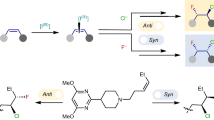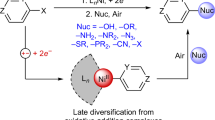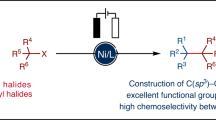Abstract
NUCLEOPHILIC substitution of a halogen atom directly attached to a double bond, as in the vinyl and phenyl halides, does not readily take place1–3. Nevertheless, cases of substitution in vinylic halides are recorded in the literature4, and facile substitution has been reported for compounds containing electron-withdrawing substituents in the β-position with respect to the halogen5. An obvious analogy exists with aromatic systems in which, as has been demonstrated by numerous experiments, nucleophilic substitution occurs readily only when electron-withdrawing groups are present at suitable positions in the ring.
This is a preview of subscription content, access via your institution
Access options
Subscribe to this journal
Receive 51 print issues and online access
$199.00 per year
only $3.90 per issue
Buy this article
- Purchase on SpringerLink
- Instant access to full article PDF
Prices may be subject to local taxes which are calculated during checkout
Similar content being viewed by others
References
Hughes, Trans. Farad. Soc., 37, 603 (1941).
Bunnett, Chem. Revs., 49, 273 (1951).
Gold, J. Chem. Soc., 1431 (1951).
Lovenich, Losen and Dierichs, Ber., 60, 950 (1927).
Autenrieth, Ber., 20, 1531 (1887); 29, 1639 (1896); Ann., 254, 222 (1889); 259, 332 (1890). Scheibler and Voss, Ber., 53, 382 (1920).
Michael, Ber., 34, 4215 (1901); J. prakt. Chem., 52, 344 (1895). Paal and Schiedewitz, Ber., 63, 766 (1930).
Author information
Authors and Affiliations
Rights and permissions
About this article
Cite this article
JONES, D., VERNON, C. Nucleophilic Substitution in Vinylic Halides. Nature 176, 791–792 (1955). https://doi.org/10.1038/176791a0
Issue date:
DOI: https://doi.org/10.1038/176791a0
This article is cited by
-
Synthesis and Biologic Evaluation of an Iodine-Labeled Entecavir Derivative for Anti-hepatitis B Virus Activity
Nuclear Medicine and Molecular Imaging (2024)
-
?-Alkylthio-substituted ?, ?-unsaturated aldehydes
Bulletin of the Academy of Sciences of the USSR Division of Chemical Science (1975)



